Fluorite Mineralization Related to Carbonatitic Magmatism in the Western Transbaikalia: Insights from Fluid Inclusions and Trace Element Composition
Abstract
:1. Introduction
2. Geological Setting
3. Analytical Methods
4. Results
4.1. Arshan
4.2. Yuzhnoe
4.3. Ulan-Ude
5. Discussion
5.1. Fluorite Geochemistry
5.2. Fluid Inclusions
5.3. Comparisons with Fluorites from Other Deposits
6. Conclusions
Author Contributions
Funding
Data Availability Statement
Acknowledgments
Conflicts of Interest
References
- Santos, R.V.; Dardenne, M.A.; De Oliveira, C.G. Rare earth elements geochemistry of fluorite from the Mato Preto carbonatite complex, Southern Brazil. Rev. Bras. Geociênc. 1996, 26, 81–86. [Google Scholar] [CrossRef]
- Palmer, D.S.; Williams-Jones, A. Genesis of the Carbonatite-Hosted Fluorite Deposit at Amba Dongar, India: Evidence from Fluid Inclusions, Stable Isotopes, and Whole Rock-Mineral Geochemistry. Econ. Geol. 1996, 91, 934–950. [Google Scholar] [CrossRef]
- Broom-Fendley, S.; Brady, A.E.; Wall, F.; Gunn, G.; Dawes, W. REE minerals at the Songwe Hill carbonatite, Malawi: HREE-enrichment in late-stage apatite. Ore Geol. Rev. 2017, 81, 23–41. [Google Scholar] [CrossRef] [Green Version]
- Xu, C.; Taylor, R.N.; Li, W.; Kynicky, J.; Chakhmouradian, A.R.; Song, W. Comparison of fluorite geochemistry from REE deposits in the Panxi region and Bayan Obo, China. J. Asian Earth Sci. 2012, 57, 76–89. [Google Scholar] [CrossRef]
- Liu, S.; Fan, H.-R.; Groves, D.I.; Yang, K.-F.; Yang, Z.-F.; Wang, Q.-W. Multiphase carbonatite-related magmatic and metasomatic processes in the genesis of the ore-hosting dolomite in the giant Bayan Obo REE-Nb-Fe deposit. Lithos 2020, 354–355, 105359. [Google Scholar] [CrossRef]
- Liu, S.; Fan, H.R.; Yang, K.F.; Hu, F.F.; Wang, K.Y.; Chen, F.K.; Yang, Y.H.; Yang, Z.F.; Wang, Q.W. Mesoproterozoic and Paleozoic hydrothermal metasomatism in the giant Bayan Obo REE-Nb-Fe deposit: Constrains from trace elements and Sr-Nd isotope of fluorite and preliminary thermodynamic calculation. Precambrian Res. 2018, 311, 228–246. [Google Scholar] [CrossRef]
- Redina, A.; Nikolenko, A.; Doroshkevich, A.; Prokopyev, I.; Wohlgemuth-Ueberwasser, C.; Vladykin, N. Conditions for the crystallization of fluorite in the Mushgai-Khudag complex (Southern Mongolia): Evidence from trace element geochemistry and fluid inclusions. Geochemistry 2020, 80, 125666. [Google Scholar] [CrossRef]
- Migdisov, A.; Williams-Jones, A.E.; Brugger, J.; Caporuscio, F.A. Hydrothermal transport, deposition, and fractionation of the REE: Experimental data and thermodynamic calculations. Chem. Geol. 2016, 439, 13–42. [Google Scholar] [CrossRef] [Green Version]
- Bulnaev, K.B. Fluorite Deposits of the Western Transbaikalia; Nauka: Novosibirsk, Russia, 1976. (In Russian) [Google Scholar]
- Lastochkin, E.; Ripp, G.; Tsydenova, D.; Posokhov, V.; Murzintseva, A. Epithermal fluorite deposits of the Transbaikalia. Russ. Geol. Geophys. 2021, 4. (In Russian) [Google Scholar] [CrossRef] [Green Version]
- Bulnaev, K.B. Late Mesozoic volcanites and fluorite deposits of the Transbaikalia and Mongolia: Age and genetis relationship. Tikhookeanskaya Geol. 2003, 22, 103–110. (In Russian) [Google Scholar]
- Bulnaev, K.B. About the source of fluorine in epithermal fluorite deposits. Tikhookeanskaya Geol. 2004, 23, 113–115. (In Russian) [Google Scholar]
- Bulnaev, K.B. The Arshan carbonatite deposit—Possible source of bastnȁsite ore. Otechestvennaya Geol. 2007, 3, 63–65. (In Russian) [Google Scholar]
- Burtseva, M.V. Hydrothermal mineralization in rare-earth carbonatites from Arshan deposit (Western Transbaikalia). Izv. SB RANS. Geol. Poiski I Razved. Rudn. Mestorozhdenii 2010, 36, 34–40. (In Russian) [Google Scholar]
- Lastochkin, E.I.; Ripp, G.S.; Tsydenova, D.S.; Posokhov, V.F.; Murzintseva, A.E. Results of isotopic study of epithermal fluorite deposits of Western Transbaikalia (source of matter and fluids). Geol. Prospect. Explor. Miner. Depos. 2018, 41, 41–53. (In Russian) [Google Scholar] [CrossRef]
- Vinokurov, S.F.; Golubev, V.N.; Krylova, T.L.; Prokof’ev, V.Y. REE and Fluid Inclusions in Zoned Fluorites from Eastern Transbaikalia: Distribution and Geochemical Significance. Geochem. Int. 2014, 52, 654–669. [Google Scholar] [CrossRef]
- Doroshkevich, A.G.; Ripp, G.S. Estimation of the conditions of formation of REE-carbonatites in western Transbaikalia. Russ. Geol. Geophys. 2004, 45, 492–500. [Google Scholar]
- Ripp, G.S.; Izbrodin, I.A.; Lastochkin, E.I.; Rampilov, M.O.; Doroshkevich, A.G.; Chromova, E.A. A new type of rare metal mineralization in the Western Transbaikalia. Otechestvennaya Geol. 2018, 3, 9–21. (In Russian) [Google Scholar]
- Petrov, O.; Leonov, Y.; Tingdong, L.; Tomurtogoo, O.; Hwang, J.Y. (Eds.) Tectonic MAP of Central Asia and Adjacent Areas; M 1:2,500,000; VSEGEI Cartographic Factory: Saint-Petersburg, Russia, 2008. [Google Scholar]
- Platov, V.S.; Tereshenkov, V.G.; Savchenko, A.A.; Busuek, S.M.; Anosova, G.B.; Polyanskii, S.A. (Eds.) State Geological Map of the Russian Federation; M. 1:200,000. Ser. Selenga. Sheet M-48-VI; VSEGEI Cartographic Factory: Moscow, Russia, 2000. [Google Scholar]
- Vorontsov, A.A.; Yarmolyuk, V.V.; Komaritsyna, T.Y. Late Mesozoic-Early Cenozoic rifting magmatism in the Uda sector of Western Transbaikalia. Russ. Geol. Geophys. 2016, 57, 723–744. [Google Scholar] [CrossRef]
- Ripp, G.S.; Doroshkevich, A.G.; Posokhov, V.F. Age of carbonatite magmatism in Transbaikalia. Petrology 2009, 17, 73–89. [Google Scholar] [CrossRef]
- Doroshkevich, A.G.; Ripp, G.S.; Viladkar, S.G.; Vladykin, N.V. The Arshan REE carbonatites, Sourthwestern Transbaikalia, Russia: Mineralogy, paragenesis and evolution. Can. Miner. 2008, 46, 807–823. [Google Scholar] [CrossRef]
- Ripp, G.S.; Kobylkina, O.V.; Doroshkevich, A.G.; Sharakshinov, A.O. Late Mesozoic Carbonatites of Western Transbaikalia; BSC SB RAS: Ulan-Ude, Russia, 2000. (In Russian) [Google Scholar]
- Ripp, G.S.; Prokopyev, I.R.; Izbrodin, I.A.; Lastochkin, E.I.; Rampilov, M.O.; Doroshkevich, A.G.; Redina, A.A.; Posokhov, V.F.; Savchenko, A.A.; Khromova, E.A. Bastnaesite and Fluorite Rocks of the Ulan-Ude Occurrence (Mineral Composition, Geochemical Characteristics, and Genesis Issues). Russ. Geol. Geophys. 2019, 60, 1407–1424. [Google Scholar] [CrossRef]
- McDonough, W.F.; Sun, S.S. The composition of the Earth. Chem. Geol. 1995, 120, 223–253. [Google Scholar] [CrossRef]
- Roedder, E. Fluid Inclusions; De Gruyter: Berlin, Germany; Boston, MA, USA, 1984. [Google Scholar]
- Steele-MacInnis, M.; Lecumberri-Sanchez, P.; Bodnar, R.J. HokieFlincs_H2O-NaCl: A Microsoft Excel spreadsheet for interpreting microthermometric data from fluid inclusions based on the PVTX properties of H2O-NaCl. Comput. Geosci. 2012, 49, 334–337. [Google Scholar] [CrossRef]
- Borisenko, A.S. Analysis of the Salt Composition of Solutions of Gas-Liquid Inclusions in Minerals by Cryometric Method. Fluid Inclusions Study for the Search and Study of Ore Deposits; Nedra: Moscow, Russia, 1982. (In Russian) [Google Scholar]
- Lafuente, B.; Downs, R.T.; Yang, H.; Stone, N. The power of databases: The RRUFF project. In Highlights in Mineralogical Crystallography; Armbruster, T., Danisi, R.M., Eds.; W. De Gruyter: Berlin, Germany, 2015. [Google Scholar]
- Mitchell, R.H. Carbonatites and carbonatites and carbonatites. Can. Miner. 2005, 43, 2049–2068. [Google Scholar] [CrossRef]
- Gagnon, J.E.; Samson, I.M.; Fryer, B.J.; Williams-Jones, A.E. Compositional heterogeneity in fluorite and the genesis of fluorite deposits: Insights from LA-ICP-MS analysis. Can. Miner. 2003, 41, 365–382. [Google Scholar] [CrossRef]
- Schönenberger, J.; Köhler, J.; Markl, G. REE systematics of fluorides, calcite and siderite in peralkaline plutonic rocks from the Gardar Province, South Greenland. Chem. Geol. 2008, 247, 16–35. [Google Scholar] [CrossRef]
- Magotra, R.; Namga, S.; Singh, P.; Arora, N.; Srivastava, P.K. A New Classification Scheme of Fluorite Deposits. Int. J. Geosci. 2017, 8, 599–610. [Google Scholar] [CrossRef] [Green Version]
- Möller, P.; Parekh, P.P.; Schneider, H.J. The application of Tb/Ca-Tb/La abundance ratios to problems of fluorspar genesis. Miner. Depos. 1976, 11, 111–116. [Google Scholar] [CrossRef]
- Bühn, B.; Rankin, A.H.; Schneider, J.; Dulski, P. The nature of orthomagmatic, carbonatitic fluids precipitating REE, Sr-rich fluorite: Fluid-inclusion evidence from the Okorusu fluorite deposit, Namibia. Chem. Geol. 2002, 186, 75–98. [Google Scholar] [CrossRef]
- Kynicky, J.; Smith, M.P.; Song, W.; Chakhmouradian, A.R.; Xu, C.; Kopriva, A.; Galiova, M.V.; Brtnicky, M. The role of carbonate-fluoride melt immiscibility in shallow REE deposit evolution. Geosci. Front. 2019, 10, 527–537. [Google Scholar] [CrossRef]
- Öztürk, H.; Altuncu, S.; Hanilçi, N.; Kasapçı, C.; Goodenough, K.M. Rare earth element-bearing fluorite deposits of Turkey: An overview. Ore Geol. Rev. 2019, 105, 423–444. [Google Scholar] [CrossRef] [Green Version]
- Rankin, A.H.; Ni, P.; Zhou, J. Fluid inclusion studies on carbonatite dyke and associated quartzite in Bayan Obo, Inner Mongolia, China. Acta Petrol. Sin. 2003, 19, 297–306. [Google Scholar]
- Smith, M.P.; Campbell, L.S.; Kynicky, J. A review of the genesis of the world class Bayan Obo Fe-REE-Nb deposits, Inner Mongolia, china: Multistage processes and outstanding questions. Ore Geol. Rev. 2015, 64, 459–476. [Google Scholar] [CrossRef]
- Walter, B.F.; Giebel, R.J.; Steele-MacInnis, M.; Marks, M.A.W.; Kolb, J.; Markl, G. Fluids associated with carbonatitic magmatism: A critical review and implications for carbonatite magma ascent. Earth-Sci. Rev. 2021, 215. [Google Scholar] [CrossRef]
- Fan, H.-R.; Yang, K.-F.; Hu, F.-F.; Liu, S.; Wang, K.-Y. The giant Bayan Obo REE-Nb-Fe deposit, China: Controversy and ore genesis. Geosci. Front. 2016, 7, 335–344. [Google Scholar] [CrossRef]
- Bühn, B.; Rankin, A.H. Composition of natural, volatile-rich Na–Ca–REE−Sr carbonatitic fluids trapped in fluid inclusions. Geochim. Cosmochim. Acta 1999, 63, 3781–3797. [Google Scholar] [CrossRef]
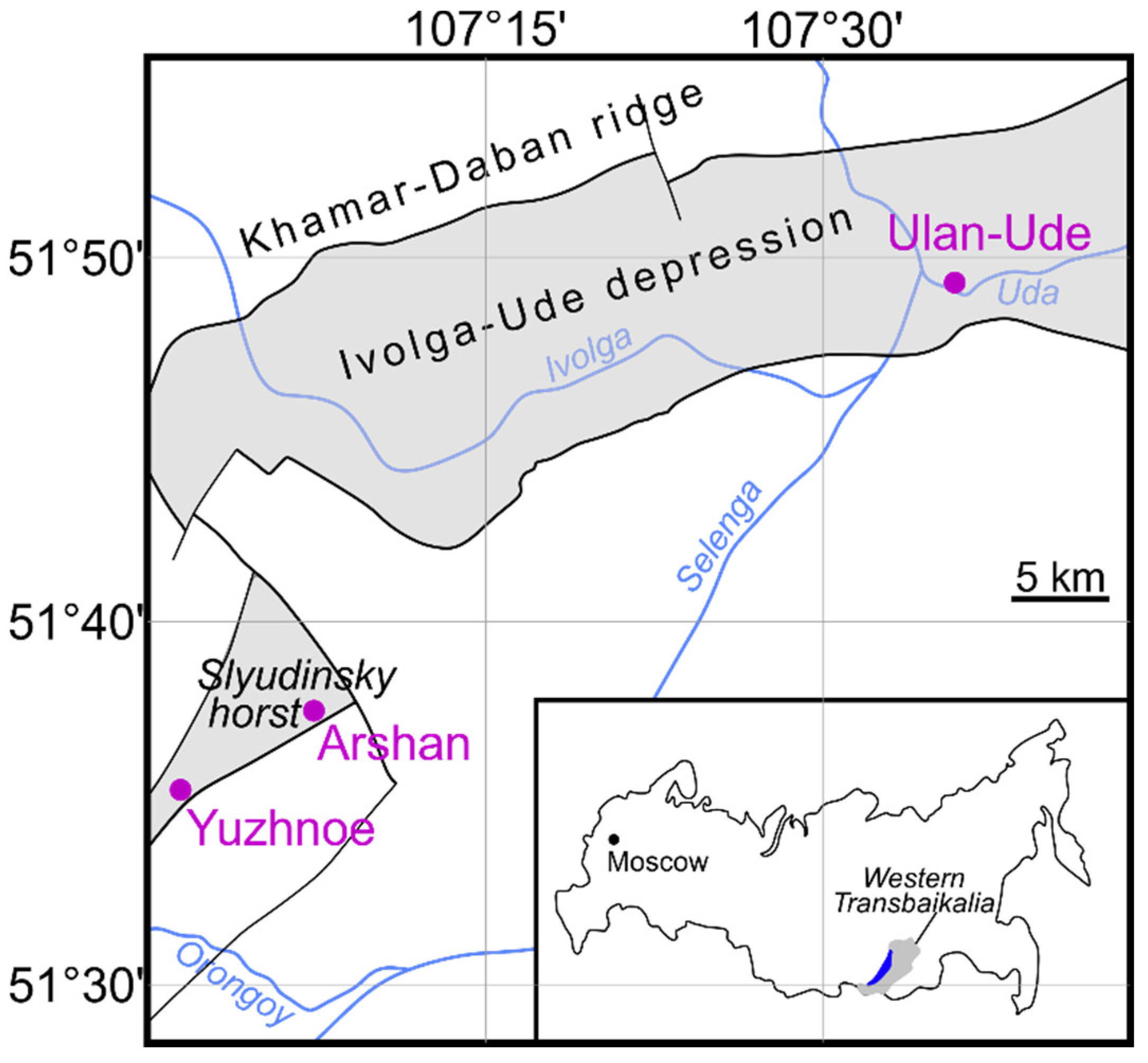
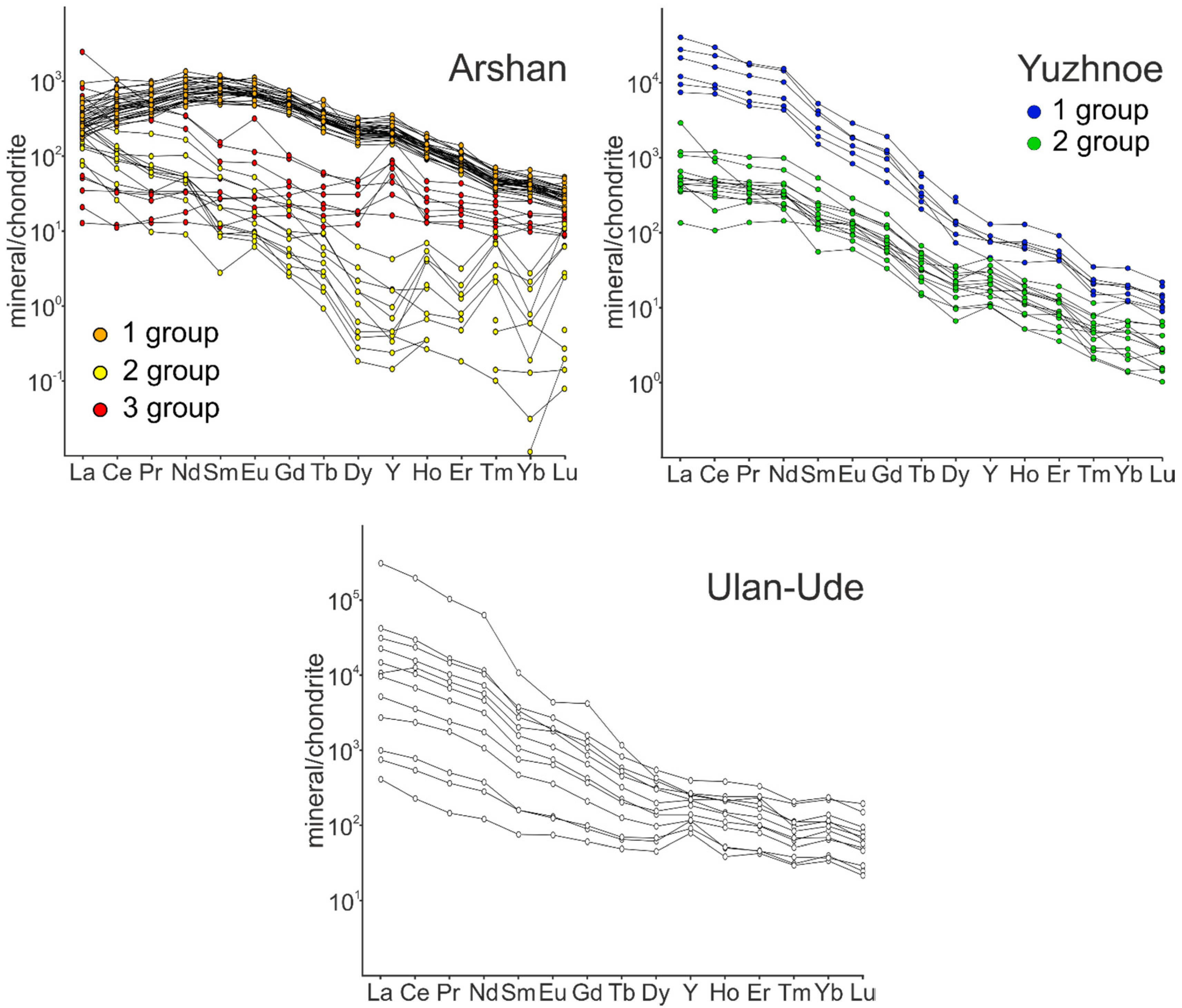
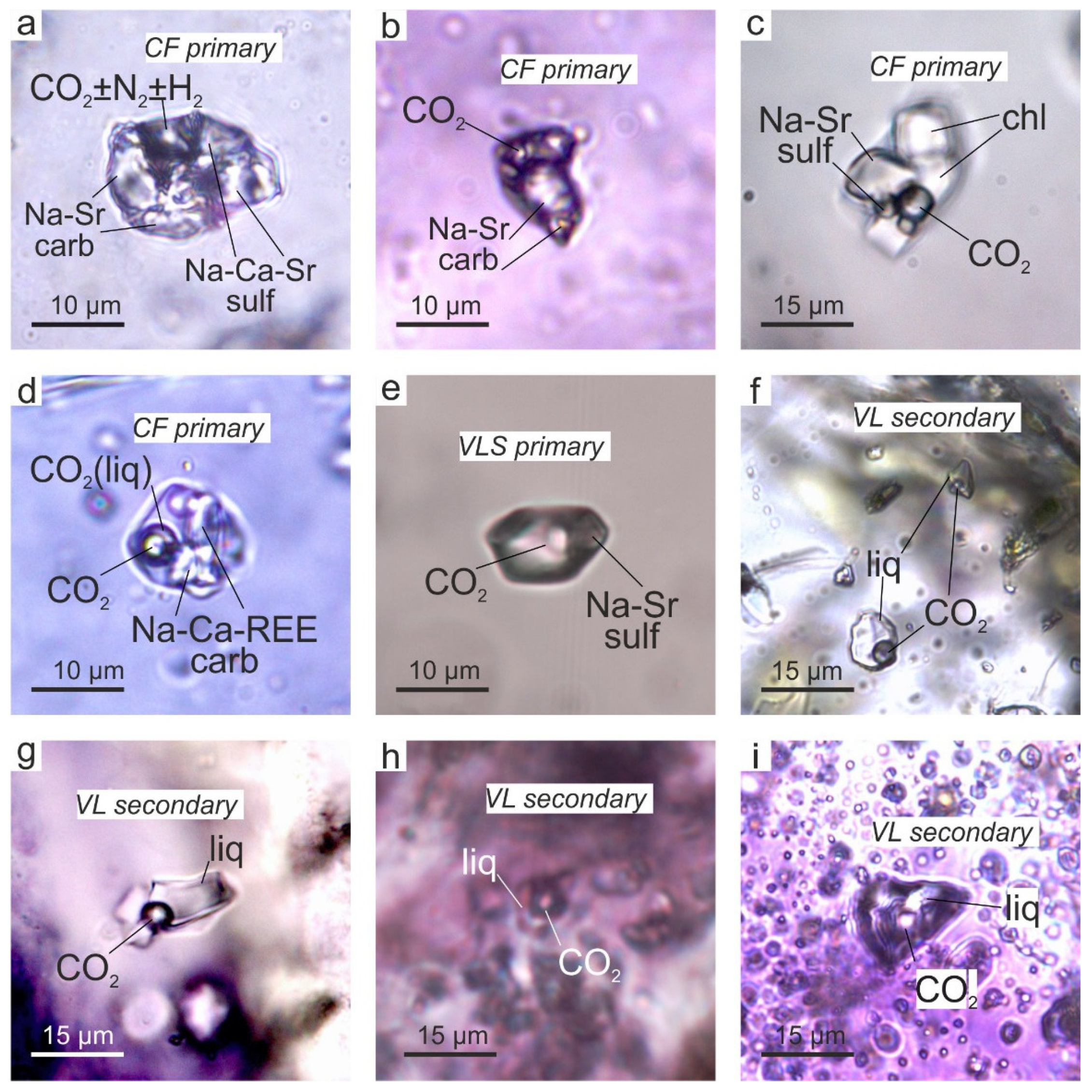

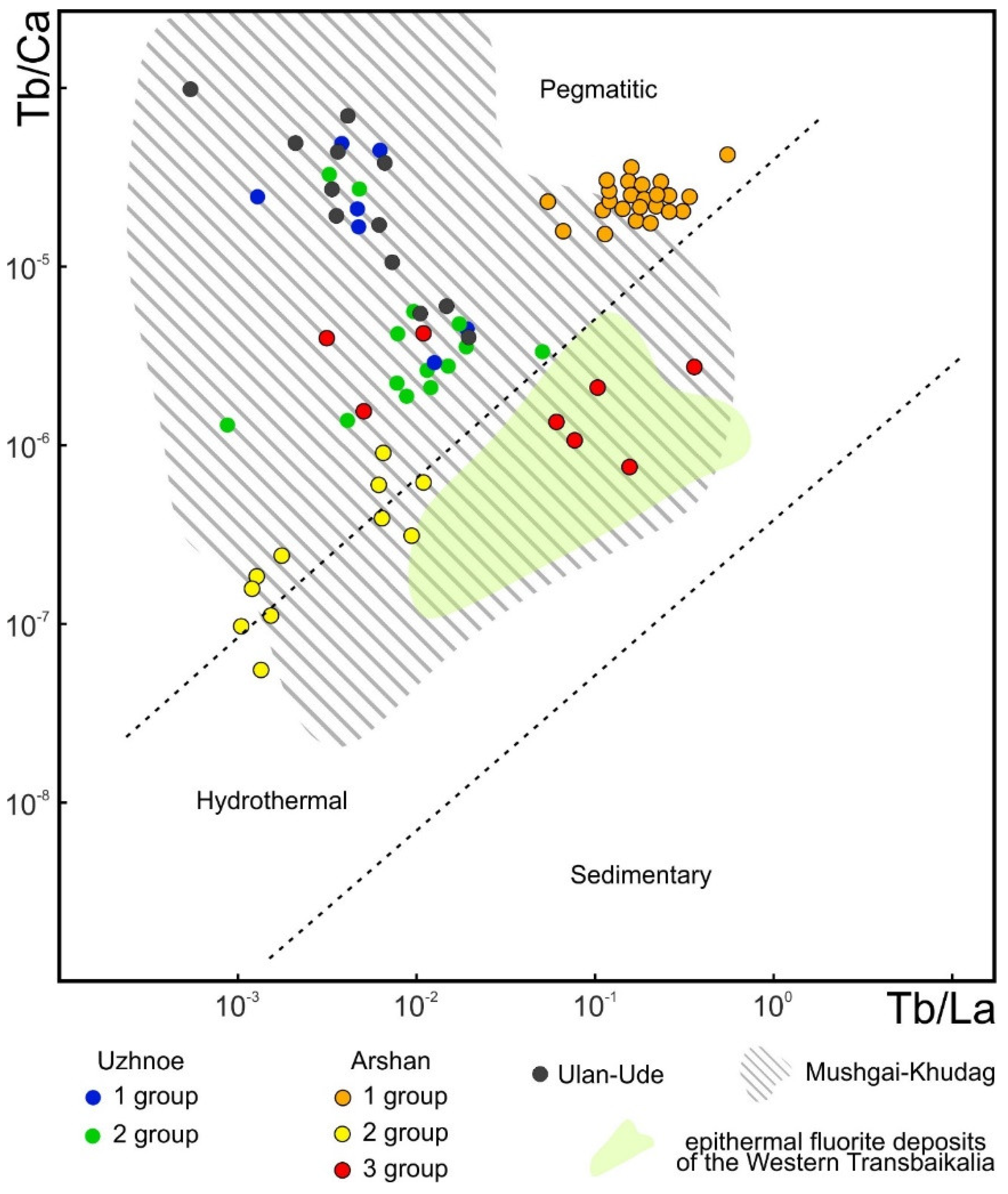
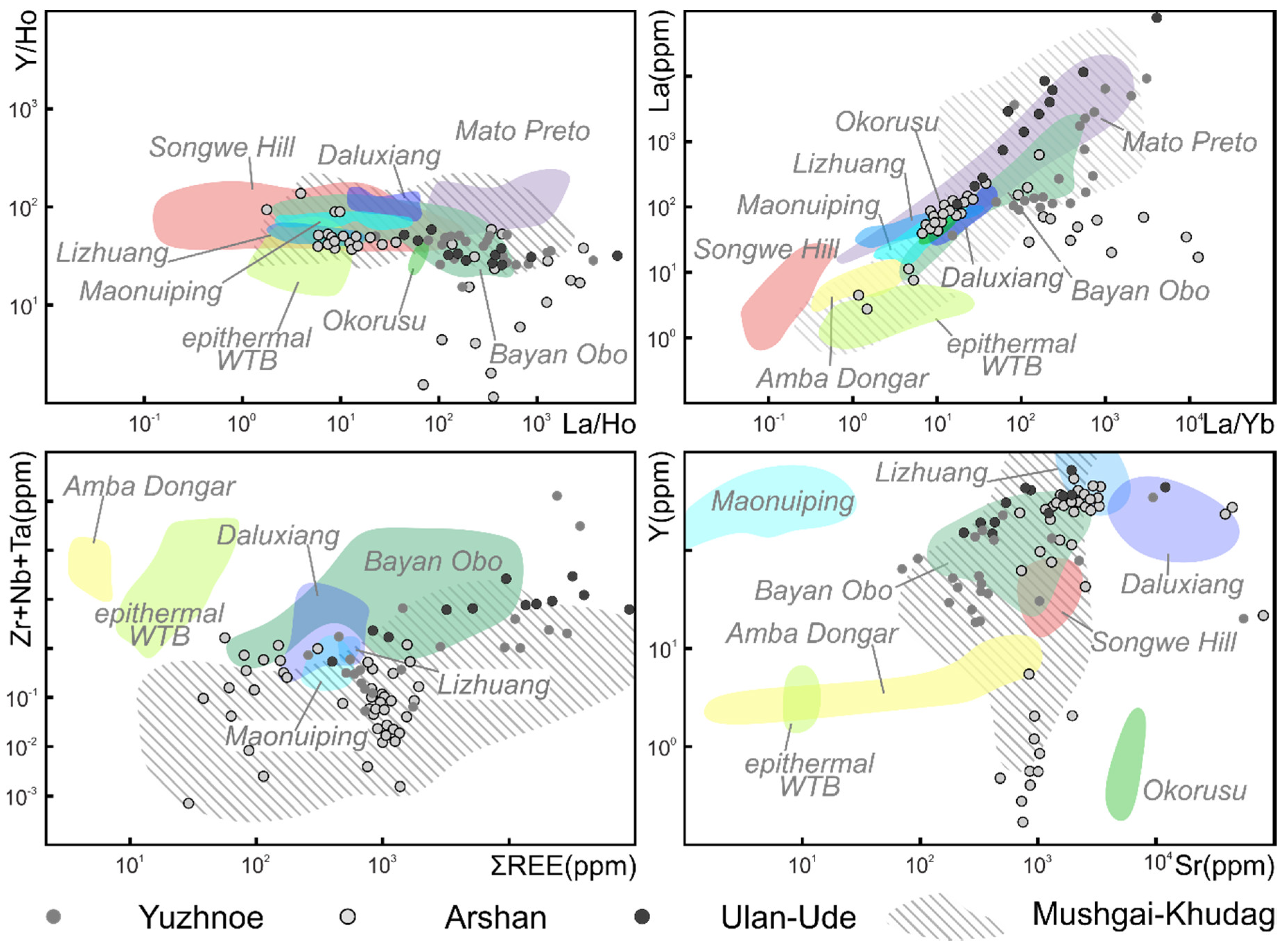
| Occurrence | Arshan | Yuzhnoe | Ulan-Ude | |||||||||||||||
|---|---|---|---|---|---|---|---|---|---|---|---|---|---|---|---|---|---|---|
| Group | 1 | 2 | 3 | 1 | 2 | |||||||||||||
| Value | med | min | max | med | min | max | med | min | max | med | min | max | med | min | max | med | min | max |
| La | 80.0 | 38.6 | 225 | 43.7 | 16.5 | 69.0 | 124 | 2.64 | 610 | 3240 | 111 | 9000 | 706 | 34.7 | 4880 | 10,000 | 108 | 83,000 |
| Ce | 290 | 147 | 640 | 57.4 | 13.9 | 124 | 152 | 5.80 | 630 | 6670 | 293 | 17,000 | 1340 | 70.0 | 9400 | 17,100 | 152 | 134,000 |
| Pr | 55.0 | 30.5 | 99.0 | 6.40 | 0.83 | 18.8 | 16.0 | 1.11 | 47.0 | 748 | 46.0 | 1720 | 173 | 14.6 | 1190 | 1570 | 15.9 | 11,500 |
| Nd | 349 | 209 | 640 | 25.1 | 3.60 | 73.0 | 59.7 | 5.30 | 157 | 3010 | 177 | 6910 | 691 | 72.0 | 4620 | 4750 | 62.3 | 33,000 |
| Sm | 116 | 71.3 | 180 | 2.86 | 0.34 | 9.40 | 9.06 | 1.46 | 21.5 | 330 | 28.2 | 776 | 93.5 | 9.10 | 562 | 371 | 12.4 | 1780 |
| Eu | 41.6 | 27.9 | 67.0 | 0.89 | 0.31 | 2.84 | 4.46 | 0.81 | 18.2 | 71.0 | 8.50 | 172 | 21.5 | 3.93 | 110 | 87.1 | 4.87 | 289 |
| Gd | 108 | 72.8 | 155 | 1.55 | 0.43 | 4.52 | 8.78 | 2.92 | 19.8 | 158 | 18.0 | 404 | 49.4 | 7.74 | 266 | 210 | 13.9 | 970 |
| Tb | 12.5 | 7.90 | 22.0 | 0.17 | 0.03 | 0.48 | 1.15 | 0.39 | 2.19 | 10.3 | 1.47 | 25.5 | 3.54 | 0.66 | 17.0 | 16.9 | 2.14 | 51.2 |
| Dy | 51.6 | 32.7 | 77.7 | 0.33 | 0.03 | 1.30 | 6.37 | 2.64 | 10.8 | 26.8 | 5.20 | 68.1 | 10.2 | 1.91 | 38.0 | 62.7 | 12.4 | 150 |
| Ho | 7.29 | 5.01 | 11.1 | 0.12 | 0.01 | 0.35 | 1.29 | 0.67 | 2.49 | 3.57 | 0.82 | 8.27 | 1.41 | 0.36 | 4.90 | 10.4 | 2.53 | 25.2 |
| Er | 13.4 | 8.80 | 22.0 | 0.17 | 0.02 | 0.44 | 3.33 | 1.70 | 6.60 | 7.61 | 1.54 | 16.8 | 3.03 | 0.71 | 10.5 | 26.5 | 7.90 | 61.9 |
| Tm | 1.29 | 0.90 | 1.92 | 0.08 | – | 0.25 | 0.46 | 0.21 | 0.79 | 0.55 | 0.08 | 1.16 | 0.26 | 0.07 | 0.79 | 2.97 | 0.97 | 6.81 |
| Yb | 6.31 | 4.31 | 10.1 | 0.12 | – | 0.38 | 2.37 | 1.42 | 3.76 | 2.99 | 0.29 | 6.31 | 1.34 | 0.28 | 3.79 | 19.3 | 6.30 | 43.8 |
| Lu | 0.82 | 0.51 | 1.43 | 0.10 | – | 0.32 | 0.36 | 0.22 | 0.54 | 0.36 | 0.05 | 0.73 | 0.17 | 0.04 | 0.47 | 2.42 | 0.71 | 6.40 |
| Y | 329 | 210 | 530 | 1.28 | 0.17 | 5.50 | 97.9 | 21.9 | 242 | 105 | 25 | 219 | 53.62 | 18.3 | 153 | 335 | 135 | 682 |
| Sr | 4980 | 1230 | 48,200 | 974 | 474 | 2100 | 12,300 | 700 | 89,000 | 841 | 197 | 2350 | 4640 | 71.0 | 60,500 | 1960 | 239 | 12,800 |
| Zr | 0.09 | – | 0.45 | 0.24 | 0.05 | 0.50 | 0.25 | 0.01 | 1.18 | 51.50 | 0.11 | 302.00 | 0.98 | 0.06 | 6.30 | 6.58 | 0.40 | 21.90 |
| Nb | 0.09 | – | 0.27 | 0.18 | 0.04 | 0.38 | 0.82 | 0.05 | 1.59 | 0.27 | 0.04 | 0.64 | 0.09 | – | 0.50 | 1.85 | 0.12 | 6.20 |
| Ta | 0.03 | – | 0.15 | 0.10 | – | 0.24 | 0.01 | – | 0.03 | 0.07 | 0.01 | 0.20 | 0.02 | – | 0.04 | 0.14 | 0.03 | 0.45 |
| La/Yb | 13 | 6 | 38 | 2800 | 123 | 12,700 | 49 | 1 | 163 | 939 | 109 | 3082 | 416 | 15 | 2025 | 464 | 17 | 3897 |
| sum REE | 1130 | 756 | 1890 | 139 | 38 | 305 | 389 | 29 | 1510 | 14,300 | 691 | 35,200 | 3100 | 251 | 21,100 | 34,300 | 402 | 265,000 |
| Eu* | 1.11 | 0.86 | 1.47 | 1.39 | 0.99 | 2.40 | 1.22 | 0.75 | 2.61 | 0.99 | 0.85 | 1.12 | 1.10 | 0.84 | 1.39 | 1.07 | 0.65 | 1.36 |
| Y* | 1.32 | 1.09 | 1.59 | 0.65 | 0.15 | 1.28 | 2.78 | 1.08 | 5.71 | 0.96 | 0.72 | 1.47 | 1.32 | 0.73 | 1.77 | 1.23 | 0.85 | 2.06 |
| Occurrence | Arshan | Yuzhnoe | Ulan-Ude | ||||
|---|---|---|---|---|---|---|---|
| FI type | CF, pr (12) | VL, s (14) | VLS, pr (10) | VL, s (15) | CF, pr (9) | VL, ps (7) | VL, s (11) |
| Thom, °C | 420–560 | 90–150 | 360–470 | 110–165 | 440–520 | 135–250 | |
| Salinity, wt.% NaCl-equiv. | 49.7–68.2 | 11.7–14 | 43.3–55.8 | 52–62.5 | 14.5–16 | ||
| Gas phase | CO2 ± N2 ± H2 | CO2 | CO2±H2 | CO2 | CO2 | CO2 ± N2 ± H2 | |
| Solid phase | Na ± Ca ± Sr sulfates and Na-Sr carbonates | Na-Sr sulfates, Na ± Ca carbonates and chlorides | Ca-Na-REE carbonates, Na-Sr sulfates and chlorides | ||||
Publisher’s Note: MDPI stays neutral with regard to jurisdictional claims in published maps and institutional affiliations. |
© 2021 by the authors. Licensee MDPI, Basel, Switzerland. This article is an open access article distributed under the terms and conditions of the Creative Commons Attribution (CC BY) license (https://creativecommons.org/licenses/by/4.0/).
Share and Cite
Redina, A.A.; Doroshkevich, A.G.; Veksler, I.V.; Wohlgemuth-Ueberwasser, C.C. Fluorite Mineralization Related to Carbonatitic Magmatism in the Western Transbaikalia: Insights from Fluid Inclusions and Trace Element Composition. Minerals 2021, 11, 1183. https://doi.org/10.3390/min11111183
Redina AA, Doroshkevich AG, Veksler IV, Wohlgemuth-Ueberwasser CC. Fluorite Mineralization Related to Carbonatitic Magmatism in the Western Transbaikalia: Insights from Fluid Inclusions and Trace Element Composition. Minerals. 2021; 11(11):1183. https://doi.org/10.3390/min11111183
Chicago/Turabian StyleRedina, Anna A., Anna G. Doroshkevich, Ilya V. Veksler, and Cora C. Wohlgemuth-Ueberwasser. 2021. "Fluorite Mineralization Related to Carbonatitic Magmatism in the Western Transbaikalia: Insights from Fluid Inclusions and Trace Element Composition" Minerals 11, no. 11: 1183. https://doi.org/10.3390/min11111183
APA StyleRedina, A. A., Doroshkevich, A. G., Veksler, I. V., & Wohlgemuth-Ueberwasser, C. C. (2021). Fluorite Mineralization Related to Carbonatitic Magmatism in the Western Transbaikalia: Insights from Fluid Inclusions and Trace Element Composition. Minerals, 11(11), 1183. https://doi.org/10.3390/min11111183





